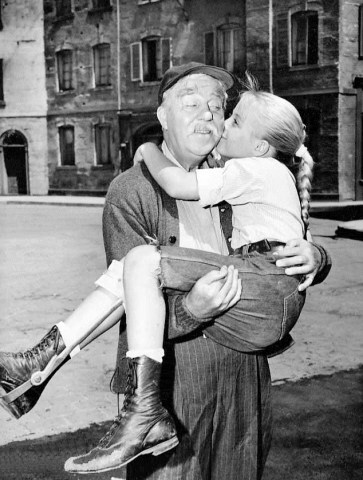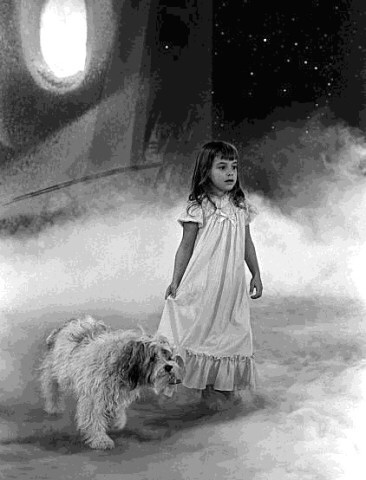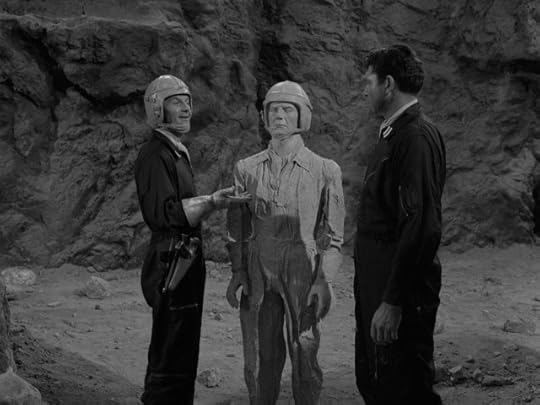September 16, 2024: Our Twilight Zone rewatch continues with season 3, episodes 25-28!
Season 3, Episode 25, “The Fugitive”
This episode first aired March 9, 1962.
Actress Susan Gordon, who played Jenny, got her start in acting when the young actress playing a Girl Scout in Attack of the Puppet People (1958) fell ill. She was drafted by the director, her father, and her performance ended up landing her an agent.
Three days into shooting this episode Gordon herself fell ill and was sent home. Production was shut down for four days while she recovered. Gordon recalled: “It was during the outdoors scenes that I was taken ill – perhaps it was a touch of sunstroke? And in the middle of the last scene of the day I could barely make it through my lines without fainting. When the director yelled “Cut!”, I walked off the set and collapsed. They carried me off the set on a stretcher as Rod Serling walked in to do his bit. I came “That close” to meeting Mr. Serling!”
J. Pat O’Malley, who played Old Ben, made over 100 t.v. guest appearances over the course of his three decade long career. Prior to acting, he recorded over 400 songs in England as a vocalist with Jack Hylton’s orchestra.
Nancy Kulp, who played Agnes Gann, was a successful character actress best known for her portrayals of the bird-loving Pamela Livingstone on The Bob Cummings Show (1955) and Miss Jane Hathaway on The Beverly Hillbillies (1962).
Episode synopsis: A weird old man kidnaps a girl so he can marry her. Really. This one was odd for all sorts of reasons. While the Ben’s friendship with the little girl may have seemed sweet, the coda that reveals she eventually became his Queen is a little…disquieting. Perhaps realizing this, Serling added that little bit at the end where he reveals Old Ben left a photo of his true appearance under the pillow for the aunt to find. But he’s still a grown man whisking off a kid who appears to be about six! Also, how does leaving the photo behind even make sense. Will the aunt find the photo under the pillow and automatically think: “Aha! This photo of a young stranger proves that old man was an alien shape-shifter and, I guess, that’s better than her ending up with a super old guy!”
Some other unintentionally funny moments. When Old Ben asks Jenny to describe the two men who came looking for him, she replies something to the effect of: “One was tall and the other had dark hair.” and Ben’s response is: “Oh, that’s them alright.”. I mean, come on. Then, later, the doctor confides in Agnes, informing her Jenny’s heartbeat is low and she is near death…but there’s nothing he can do for her! How about sending her to the hospital?!!
All in all, not good, not good at all. Although, judging by some of the reviews I’ve read, I may be in the minority here.
Season 3, Episode 26, “Little Girl Lost”
This episode first aired March 16, 1962.
According to writer Richard Matheson, the idea for this episode came to him as a result of an alarming incident involving his own daughter: “She cried out one night and I went to where she was and couldn’t find her anywhere. I couldn’t find her on the bed, I couldn’t find her on the ground. She had fallen off and rolled all the way under the bed against the wall. At first, even when I felt under the bed, I couldn’t reach her. It was bizarre, and that’s where I got the idea.”
Matheson named the mother and daughter in this episode, Ruth and Tina, after his own wife and daughter.
This episode may have served as inspiration for the 1982 movie Poltergeist. According to Matheson: “Yeah, I know, but if I’d sued, I would’ve been clobbered – too much money on the other side. Spielberg asked me if he could see a cassette of Little Girl Lost, and I sent him one, he looked at it, then sent it back, and I never heard until some one said “Hey, I see they made your Twilight Zone into a a movie.” Of course, there was a lot more to the movie but, cetainly, that was part of it. I’ve said it before, I think maybe Spielberg knows this, and always came to me with some kind of offer that would compensate, to repay me, like writing the script for Twilight Zone: The Movie, or having me as a consultant on Amazing Stories.”
According to producer Buck Houghton, the show’s Art Director came to him concerning the location, “Interior. Limbo”, slugged in the script and asked him what he was supposed to do. Houghton told him: “It’s up to you.” According to Houghton: “He broke his neck to make a limbo set. That’s challenge and response. That’s what the scripts were full of. From the asssistant prop man to the cameraman, they worked their ass off. They wanted to do the scripts justice, and that made a lot of difference in how the episodes looked. The crew was absolutely thrilled to see how the shows were going to come off.”
In the lead up to “Little GIrl Lost”, however, Matheson was very concerned about how some of his previous episodes had turned out, complaining to Serling about the direction in episodes like “The Invaders” and “Once Upon a Time”. Serling wrote back, sympathizing with Matheson: “There’s no question but that both the Keaton thing and the Agnes Moorehead thing were damaged rather than helped by the director.” Still, he stood up for the directors, arguing that their overall work was solid. Perhaps as a result of Matheson’s complaint, former actor Paul Stewart assumed the directing reins for this episode.
Actor Charles Aidman, who played Bill, would later serve as the narrator for the first two seasons of the 1985 relaunch of The Twilight Zone.
Tracy Stratford, who played young Tina, later appeared in “Living Doll” (1963), about a doll named Talky Tina. Three years later, she would provide the voice of Lucy in A Charlie Brown Christmas (1965).
Rhoda Williams was actually the voice of young Tina in this episode. She played the part of Betty, Robert Young’s oldest daughter, on the Father Knows Best radio show.
Mags, the family dog, was actually named Rags.
Another episode where I loved the idea but really didn’t think much of the execution. A lot of these early shows lack nuance and have characters react in preposterous ways as shortcuts to serve the plot. Case in point, the parents calling their buddy, the physicist, instead of the police. And, in turn, the physicist hitting on his hypothesis with really all not that much to go on. If this episode had been written today, the writer would surely have done a better job of rolling this out in a more logical manner. This episode kind of reminded me of Mark Z. Danielewski’s House of Leaves which is an absolutely wild book if you’re up for an unusual reading experience.
Overall, just a meh for me on this one.
Season 3, Episode 27, “Person or Persons Unknown”
This episode first aired March 23, 1962.
This was one of the first television episodes in which a husband and wife are depicted sharing a bed. At the time, T.V. Standards and Practices required married couples to sleep in separate beds. In “Person or Person’s Unknown” and season 5’s “Stopover in a Quiet Town”, a husband and wife are seen sleeping in the same bed – although, in both cases, the husband is fully clothed, sleeping on top of the covers, and is still wearing his shoes, suggesting he conked out after a night of drinking.
In an early draft of the script, Dr. Kolensko followed David Gurney to the photo shop where it is reveaeled David’s wife is no longer in the picture. A distraught David leaps off a balcony. But, when Kolensko hurries downstairs, there is no sign of David. Confused, the good doctor returns to his sanitorium only to discover…nobody remembers him!
The uncredited mental patient who imagines himself to be Winston Churchill was actually episode director John Brahm.
Actor Richard Lang, who played David Gurney, was one of the first Hollywood actors to be drafted into the Korean War. His Rex Randolph character’s transition from Bourbon Street Beat to 77 Sunset Strip in 1960 marked the first time a t.v. character moved between shows.
Plagued by heart trouble as a result of damage he sustained from a childhood bout with pneumonia, Lang suffered multiple heart attacks and died at the all-too-young age of 47.
Frank Silvera, who played Dr. Koslenko, was active in the Civil Rights movements of the 50’s and 60’s. He received a Tony Award nomination in 1963 as Best Featured Actor in a Play for his portrayal of M. Duval in “The Lady of the Camellias.” He died after being electrocuted while attempting to fix a home garbage disposal unit.
Another episode that tackles the familiar theme of loss of identity, but it does so in compelling and credible fashion. No wild leaps in logic here. Instead, the character’s building anxiety and increasing desperation really grounds the episode despite its out-there premise. The ending was ambiguous but, for me, not necessarily in a good way. Is the final scene intended to suggest his wife is in the same place he was at the beginning of the episode? If so, why does he recognize her? Or is it a completely different situation where, for example, he has almost made it back to his reality, ending up in an alternate world where the people surrounding him are different but playing similar roles? Close enough? I preferred Matheson’s original twist ending.
All in all, however, probably good enough to end up in my season 3 Top 10. But we’ll see.
Season 3, Episode 28, “The Little People”
This episode first aired March 30, 1962.
This episode was shot on MGM’s Stage 5. The costumes were reuses from Forbidden Planet (1956).
The rocket launch featured was actually a test flight of the Mercury-Atlas booster. A month prior to this episode airing, John Glenn became the first astronaut to attain Earth orbit in this type of rocket.
In the original cut, Peter makes a run for it, trips and falls. He turns around as an ominous shadow looms over him and screams. For some reason, this ending was reshot and the run excised.
Both Claude Adkins and Joe Maross made previous Twilight Zone appearances, Adkins in “The Monsters Are Due On Maple Street” and Maross in “Third From the Sun”.
This episode inspired segments in The Simpsons and Futurama and, it is suspected, The Outer Limits’ “Sandkings” episode.
This one is apparently a somewhat divisive episode in the Twilight Zone fandom with many finding it a subpar episode while others argue it is an underappreciated classic. While I think the premise is unarguably a classic, I would side with the former group as I wasn’t all that impressed with this one. My biggest gripe was the fluctating size of the miniature community. Overall, I rate this one solidly okay.
The post September 16, 2024: Our Twilight Zone rewatch continues with season 3, episodes 25-28! appeared first on Joseph Mallozzi's Weblog.
Joseph Mallozzi's Blog
- Joseph Mallozzi's profile
- 39 followers







